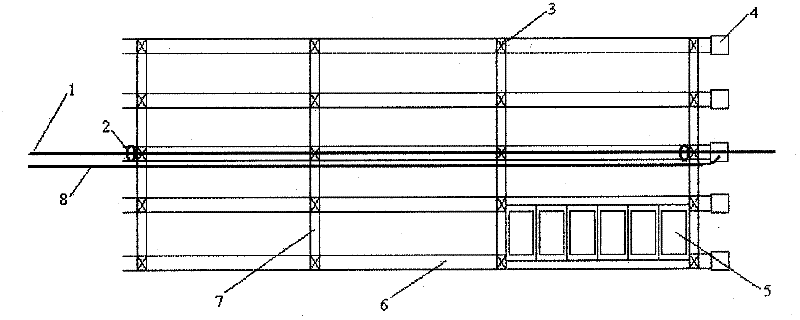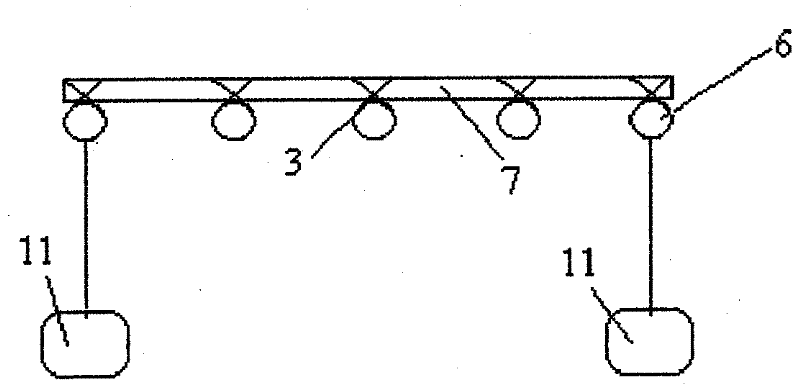Method for cultivating blue crabs with heavy shells on floating rafts
A technology for floating rafts and crabs, which is applied in the field of breeding heavy-shelled blue crabs on floating rafts, can solve the problems of limiting the output of heavy-shelled crabs, and achieve the effects of low cost, high efficiency and large scale
- Summary
- Abstract
- Description
- Claims
- Application Information
AI Technical Summary
Problems solved by technology
Method used
Image
Examples
Embodiment 1
[0021] (1) floating rafts 18 are arranged along the length direction of the pond, and the length is half of the length of the pond. Floating raft 18 is made of the polyvinyl chloride (PVC) pipe 6 of diameter 4 centimeters, and a floating raft 18 is generally connected with each other by a plurality of 4 meters long PVC pipes 6, and every row is 5, forms 4 row and puts the box fence of crab box 5 (the width is just as far as the field of view at a glance). PVC pipe 6 road two ends cover PVC cap 4, to prevent water from entering. The length of the floating raft 18 depends on the length of the pond. The floating raft 18 is divided into small units of 110 x 110 cm each, bound and connected by a narrow piece of wood (2.5 cm wide x 2.0 cm thick x 110 cm long), or the wood is replaced by a small polyvinyl chloride pipe with a smaller diameter than the main pipe . A piece of wood or a small tube is tied horizontally to the main tube. Each part (section) separated by wood can accom...
Embodiment 2
[0028] (1) floating rafts 18 are arranged along the length direction of the pond, and the length is half of the length of the pond. Floating raft 18 is made of polyvinyl chloride (PVC) pipe 6 with a diameter of 6 centimeters, and a floating raft 18 is generally connected to each other by a plurality of 4-meter-long PVC pipes 6, with 5 in every row, forming 4 rows of enclosures for placing crab boxes 5 (the width is just as far as the field of view at a glance). The two ends of the PVC pipe 6 cover the PVC pipe cap 4 to prevent water from entering. The length of the floating raft 18 depends on the length of the pond. The floating raft 18 is divided into small units of 110 x 110 cm each, bound and connected by a narrow piece of wood (2.5 cm wide x 2.0 cm thick x 110 cm long), or the wood is replaced by a small polyvinyl chloride pipe with a smaller diameter than the main pipe . A piece of wood or a small tube is tied horizontally to the main tube. Each part (section) separat...
Embodiment 3
[0035] (1) floating rafts 18 are arranged along the length direction of the pond, and the length is half of the length of the pond. Floating raft 18 is made of the polyvinyl chloride (PVC) pipe 6 of diameter 7 centimeters, and a floating raft 18 is generally connected with each other by a plurality of 4 meters long PVC pipes 6, and every row is 5, forms 4 row and puts the box fence of crab box 5 (the width is just as far as the field of view at a glance). PVC pipe 6 two ends cover PVC cap 4, to prevent water from entering. The length of the floating raft 18 depends on the length of the pond. The floating raft 18 is divided into small units of 110 x 110 cm each, bound and connected by a narrow piece of wood (2.5 cm wide x 2.0 cm thick x 110 cm long), or the wood is replaced by a small polyvinyl chloride pipe with a smaller diameter than the main pipe . A piece of wood or a small tube is tied horizontally to the main tube. Each part (section) separated by wood can accommodat...
PUM
 Login to View More
Login to View More Abstract
Description
Claims
Application Information
 Login to View More
Login to View More - R&D
- Intellectual Property
- Life Sciences
- Materials
- Tech Scout
- Unparalleled Data Quality
- Higher Quality Content
- 60% Fewer Hallucinations
Browse by: Latest US Patents, China's latest patents, Technical Efficacy Thesaurus, Application Domain, Technology Topic, Popular Technical Reports.
© 2025 PatSnap. All rights reserved.Legal|Privacy policy|Modern Slavery Act Transparency Statement|Sitemap|About US| Contact US: help@patsnap.com



